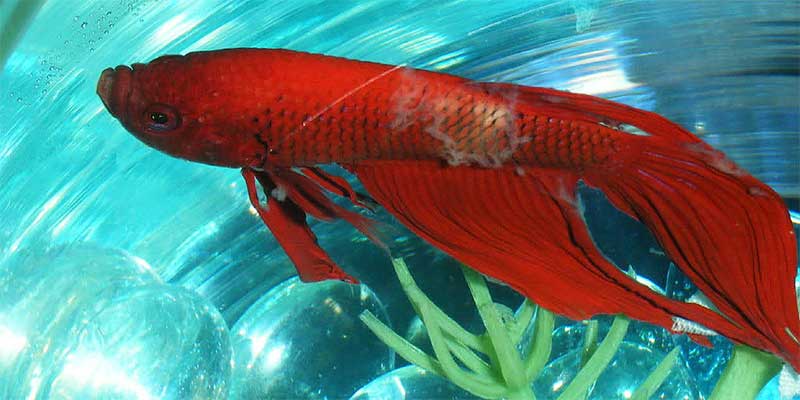Betta Fish Diseases (With Pictures): A Complete Guide for Healthy Betta Care

Betta fish, also known as Siamese fighting fish, are loved for their vivid colors and unique personalities. However, like all pets, they are susceptible to various diseases. Recognizing these illnesses early is crucial to providing proper treatment and care to ensure a long and healthy life for your betta. In this guide, we’ll explore common betta fish diseases with visual aids to help identify symptoms and take appropriate action.
1. Fin Rot
Symptoms: Fin rot is characterized by torn or ragged fins that may appear darker or discolored at the edges. It often results from bacterial or fungal infections and is commonly associated with poor water conditions.
Causes:
- Bacterial or fungal infection
- Poor water quality
- Stress from tank mates or sudden environmental changes
Treatment:
- Perform a partial water change and maintain clean water conditions.
- Use antibacterial or antifungal medications, like aquarium salt or betta-specific treatments.
- Keep your tank warm (around 78-80°F), as bettas are tropical fish.
2. Ich (White Spot Disease)
Symptoms: Ich manifests as tiny white spots covering the betta’s body, gills, and fins. It may look like grains of salt on the fish’s skin. Infected fish may also show signs of lethargy, loss of appetite, and frequent scratching against tank decorations.
Causes:
- Parasitic infection (Ichthyophthirius multifiliis)
- Sudden temperature fluctuations
- Poor water quality
Treatment:
- Increase the tank temperature gradually to around 82-85°F to speed up the life cycle of the parasite.
- Treat the water with an ich-specific medication.
- Perform regular water changes and avoid introducing new fish without proper quarantine.
3. Velvet
Symptoms: Velvet appears as a rusty or golden dust coating on the betta’s body. Affected fish may rub against tank decorations or plants, display clamped fins, and exhibit lethargy.
Causes:
- Parasitic infection (Piscinoodinium)
- Stress and weakened immune system
- Poor water quality
Treatment:
- Use a copper-based medication specifically designed for velvet treatment.
- Increase the water temperature to around 80-82°F.
- Keep the tank dim, as velvet parasites thrive in light.
4. Dropsy
Symptoms: Dropsy is a bacterial infection that causes the betta’s body to swell with fluid, leading to a bloated appearance and protruding scales that resemble a pine cone.
Causes:
- Bacterial infection (often Aeromonas)
- Poor water quality
- Stress and weakened immune system
Treatment:
- Isolate the infected fish to a quarantine tank.
- Administer antibacterial medications specifically for dropsy.
- Maintain optimal water conditions to prevent future occurrences.
5. Swim Bladder Disorder
Symptoms: Betta fish with swim bladder disorder may struggle to swim properly, float at the top of the tank, or sink to the bottom. This condition affects the fish’s buoyancy and can be caused by dietary issues.
Causes:
- Overfeeding or constipation
- Physical injury
- Poor water conditions
Treatment:
- Fast your fish for 24-48 hours to help relieve constipation.
- Feed peeled, cooked peas or a specialized diet to aid digestion.
- Ensure water temperature is between 78-80°F.
6. Popeye
Symptoms: Popeye is characterized by one or both eyes protruding abnormally. It is often due to a bacterial infection or injury and can cause further complications if left untreated.
Causes:
- Bacterial infection
- Physical injury
- Poor water quality
Treatment:
- Perform regular water changes to improve water quality.
- Use antibacterial medication designed for aquarium use.
- Ensure a stress-free environment for your betta.
7. Fungal Infections
Symptoms: Fungal infections appear as white or cotton-like growths on the skin, gills, or fins of the betta. These infections are common in tanks with poor water quality and can lead to more severe health problems.
Causes:
- Fungal spores in the water
- Poor water conditions
- Physical injuries that allow infection to set in
Treatment:
- Use antifungal medication available for aquarium use.
- Maintain a clean tank and ensure adequate filtration.
- Remove any sharp objects that could harm the betta.
Tips for Preventing Betta Fish Diseases
- Maintain Clean Water: Regularly change the water and use a water conditioner to remove harmful chemicals.
- Use a Filter: A good filter helps keep the water clean, reducing the risk of infections.
- Avoid Overcrowding: Bettas are territorial fish, so overcrowding can lead to stress and injury.
- Feed a Balanced Diet: Provide a variety of high-quality betta food to ensure proper nutrition.
Monitor Water Temperature: Keep the water temperature consistent (78-80°F) to support your betta’s immune system
Leave a Comment